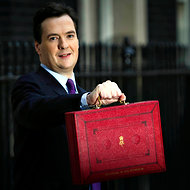Remarkably, five years after the crisis, the health of the financial industry is just as hard to determine. A major bank or financial institution could meet every single regulatory requirement yet still be at risk of collapse, and few of us would even know it. Despite endless calls for change, many of the economists I’ve spoken with have lamented that the reports that banks issue about their finances remain all but useless. The sprawling Dodd-Frank Act, which rewrote banking regulation in 2010, didn’t resolve things so much as inaugurate a process of endless rules-writing by regulators. Meanwhile, the European Union is in the early stages of figuring out how it will change the way it regulates banks; and the gargantuan issue of coordinating regulations across borders has only barely begun. All of these regulatory decisions are complicated, in part, by a vast army of financial-industry lobbyists that overwhelms the relatively few consumer advocates.
Economists have also been locked in their own long-running arguments about how to make the banking industry safer. These disagreements, which are generally split between the left and the right, can have the certainty and anger of religious wars: the right accuses the left of hobbling banks and undermining prosperity; the left counters that the relatively lax regulation advocated by the right will lead to a corrupt oligarchy. But there actually is consensus on one of the most important issues. Paul Schultz, director of the Center for the Study of Financial Regulation at the University of Notre Dame, led a project that brought together scholars of financial regulation from the left, the right and the center to figure out what caused the financial crisis and how to prevent a sequel. They couldn’t agree on anything, he told me. But a great majority favored higher equity requirements, which is bankerspeak for the notion that banks shouldn’t be allowed to borrow so much.
I conducted my own Schultz test by talking to Anat Admati and Charles Calomiris, prominent finance professors at Stanford and Columbia, respectively, who roughly define the opposite ends of the argument over bank regulation. Admati is a Democrat, Calomiris a Republican. In her recent book, “The Bankers’ New Clothes,” for example, Admati has argued that bankers misrepresent their finances. Calomiris, who used to be a banker, is generally seen as friendly to the field. As I spoke to them both, they also disagreed on everything until the conversation turned to borrowing. At which point, they independently explained that banks borrow too much, that the government rules are too confusing and that the public has been misled.
I asked Admati and Calomiris to explain their problem with the current system. I randomly chose Citigroup’s most recent annual S.E.C. report, a 300-page tome filled with complex legal jargon outlining the bank’s performance. The key number that we looked for was the capital-adequacy ratio, which is a measure of how much capital you need to back up the risk of your assets. This is supposed to be the one number that makes clear whether a bank is prepared for a crisis. A high ratio means the bank’s owners could bear most losses without requiring a bailout. A low number means the opposite.
It was extremely hard, though, to know how Citi was faring. Calomiris pointed out that the bank reports several different measures, ranging from what appears to be a safe capital ratio of 17.26 percent (implying the bank maintains a loss-absorbing buffer of $17 for every $100 of the assets it owns) to a potentially worrisome 7.48 percent (with stops at 14.06, 12.67 and 8.7 percent). When I asked Admati how healthy the bank was, she replied, “It’s hopeless for anyone to know.”

Article source: http://www.nytimes.com/2013/08/11/magazine/financial-crisis.html?partner=rss&emc=rss

